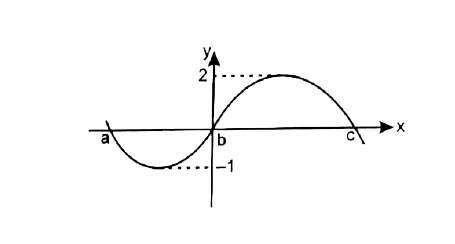Which of the following statements are true where ϕ(x) is a polynomial.
between any two roots of ϕ(x)=0 lies atleast one root of ϕ(x)+γϕ(x)=0
between any two roots of ϕ(x)=0 lies atleast one root of xϕ(x)+γϕ(x)=0
between any two roots of ϕ(x)=0 lies atleast one root of (x2+1)ϕ(x)+ϕ(x)=0
between any two roots of ϕ(x)=0 lies atleast one root of ϕ'(x)+xϕ(x)=0
The correct Answer is:A, C, D
Topper's Solved these Questions
- APPLICATION OF DERIVATIVEBOOK - FIITJEECHAPTER - APPLICATION OF DERIVATIVEEXERCISE - Comprehension
8 Videos
- APPLICATION OF DERIVATIVEBOOK - FIITJEECHAPTER - APPLICATION OF DERIVATIVEEXERCISE - MATCH THE COLUMNS
4 Videos
- APPLICATION OF DERIVATIVEBOOK - FIITJEECHAPTER - APPLICATION OF DERIVATIVEEXERCISE - Assignment Objective (level-1)
52 Videos
- AREABOOK - FIITJEECHAPTER - AREAEXERCISE - Numerical Based
3 Videos
Similar Questions
Knowledge Check
Let f (x) be a polynomial function of degree 3 where a<b<candf(a)=f(b)=f(c). If the graph of f (x) is as shown, which of the following statements are INCORRECT ? (Where c>|a|)
 A∫caf(x)dx=∫cbf(x)dx+∫bcf(x)dxB∫caf(x)dx<aC∫baf(x)dx<∫bcf(x)dxD1b−a∫baf(x)dx>1c−b∫cbf(x)dx
A∫caf(x)dx=∫cbf(x)dx+∫bcf(x)dxB∫caf(x)dx<aC∫baf(x)dx<∫bcf(x)dxD1b−a∫baf(x)dx>1c−b∫cbf(x)dxIf g(x)=(x−2)2−5, which of the following statements is true ?
AThe function g (x) is increasing over the entire domain.BThe functin g (x) is decreasing over the entire domain.CThe function g (x) is increasing for x<2 and decreasing for x>2.DThe function g (x) is decreasing for x<2 and increasing for x>2.For function f(x)=lnxx, which of the following statements are true?
Af(x) has horizontal tangent at x = eBf(x) cuts the X-axis only at one pointCf(x) is many-one functionDf(x) has one vertical tangent
Which of the following statements are true ?
ϕ⊂{a,b,c}
View SolutionWhich of the following statements are true: (A) ∣∣tan−1x−tan−1y∣∣≤|x−y| , where x, y are real numbers.
View SolutionState which of the following is true? ϕ={ϕ}
View SolutionLet f (x) be a polynomial function of degree 3 where a<b<candf(a)=f(b)=f(c). If the graph of f (x) is as shown, which of the following statements are INCORRECT ? (Where c>|a|)

View SolutionWhich of the gien statement(s) is (are) true? (A) A⊆B (B) A=B=ϕ (C) A∩B≠ϕ (D) B⊆A
View Solution
